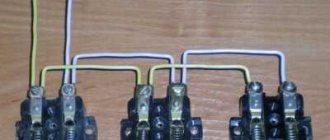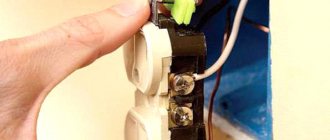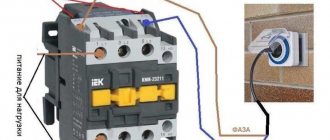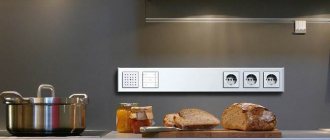Replacing or installing an outlet in most cases does not require calling a technician to your home. It is enough to familiarize yourself with the theory and safety rules to get started and complete it quite successfully.
Often in the kitchen or in any other room where several household appliances are used simultaneously, there is a catastrophic lack of a free outlet.
The problem can be solved by installing a double socket.
What do you need to know before connecting a double socket?
Before starting work, it is necessary to determine what phase and zero are in electrics, i.e. wire affiliation. To do this you will need a tester screwdriver and rubber gloves.
The cover of the old socket is removed and measurements are taken using a tester. In phase, the indicator will light up, and the neutral wire will be indicated by the absence of a light signal. Of course, there is color marking of cables, but it’s better to be safe.
Then the line must be de-energized through the meter - this is a basic safety rule. The machine levers are switched to the off position! This is the bottom position of the switches.
The voltage at the installation site of the double socket is checked again.
If there is still current in the phase (that is, the line is not de-energized), it is necessary to turn off all the circuit breakers, and not just those that, as you think, control the wires going to the outlet.
Before installing a double socket, you will need the following tools and materials:
- insulating tape;
- sharp knife for stripping wires;
- Phillips and flat head screwdriver;
- pliers.
In the process of connecting
grounded socket
, you must remember the wiring rule: on the right is the phase, on the left is the neutral, and a grounding cable is connected to the central or upper terminal of the device.
A separate article is devoted to identifying faults in sockets and their repair.
Double sockets are single terminal devices equipped with distribution strips.
On a note. Such an outlet is not very convenient if you plan to use two powerful devices - the voltage is the same, but the current strength in each outlet will depend on the load of the adjacent one. Therefore, it is preferable to connect two outlets in parallel.
The cable is of the same cross-section as the main wiring in the room. The materials must also be the same. If the wiring is made with aluminum wire, it is also used when connecting sockets.
Use of the device requires caution. The total load on this type of outlet should not exceed 10-16 A.
Options for arranging two outlets from one
Having decided to independently install an additional electrical outlet, you will need to learn how to correctly install a new outlet from an existing outlet and familiarize yourself with the recommendations and advice of experienced craftsmen.
If you do not have confidence in your own abilities, then it is better to invite an electrician who has considerable practical experience behind him.
When installing an additional outlet yourself, you have to decide what it will be like:
- a new point , a couple of meters away from the existing one;
- double model instead of single;
- a whole block of 3-6 points.
Depending on your individual needs, you should choose the most appropriate option. If there is simply not enough one more electrical point to turn on all the necessary devices, then it is more convenient and easier to install a dual model.
Even a beginner who has no experience or special knowledge of electrical installation work can implement such a solution.
The electric stove requires a separate power cable that can withstand a large load
When you move the sofa in the room and change the location of the TV, or buy a PC for older children, you can’t get by with a double socket. You will need to install an additional one or two new ones.
And if the power consumption needs are higher, but the thickness of the wire cross-section allows it, it is best to install a block with 4-6 slots. This solution can fit harmoniously into the interior without cluttering the walls with unnecessary details.
Installation steps - do everything in order
The double socket connection diagram consists of the following steps:
- A suitable place is selected on the wall. Typically the outlet is located near an electrical distribution box or a wire running in the wall.
- Its base is outlined with a pencil. At the marked place, using a hammer drill, make a recess sufficient to fit the inner housing (glass) of the socket.
- A hole is made in the glass through which the wires are brought out, and then it is fixed with cement or alabaster. The solution is given time to harden. You can also secure the glass using dowels, which will speed up installation time.
- The socket is unscrewed using a screwdriver. The outer panel is separated from the inner mechanism.
- The wires located in the glass (socket box) are shortened with pliers. Using a knife, the insulation is removed from each wire to a length of 0.8 to 1 centimeter. The edges of the cores are folded up for ease of assembly.
- The phase and neutral are attached to different terminals of the mechanism (side), and the grounding is strengthened in the central connector.
- Then the mechanism is secured in the glass with special screws (fastening). They are on the sides.
- The front panel is installed on top and clamped with screws.
- The machines are turned on, the socket is checked for operation. A simple table lamp is used as a testing device, and not some expensive household appliance like a TV or computer.
This completes the installation work. If the quality of the installation is in doubt, you should contact a professional electrician. He will inspect your work and make sure that operation will not lead to electric shock.
Installation and connection of sockets by professionals. Price
Installation and connection of sockets by professionals in Moscow and the Moscow region are carried out approximately at the following prices:
| Connecting and installing sockets | ||
| Installing an outdoor outlet | PC. | 300 rub. |
| Installing an indoor outlet | PC. | 250 rub. |
| Installing a RJ45 computer socket (Internet) | PC. | 250 rub. |
| Installation of a television outlet (TV) | PC. | 250 rub. |
| Installation of telephone socket RJ11, RJ12, RJ45 | PC. | 250 rub. |
| Installing a dimmer (dimmer) | PC. | 300 rub. |
| Installing a rheostat for a heated floor (thermostat) | PC. | 600 rub. |
| Installing a socket for an electric stove | PC. | 600 rub. |
| Drilling holes for socket boxes | ||
| In plasterboard ⌀ 75mm | PC. | 150 rub. |
| In brick, wood ⌀ 75 mm | PC. | 200 rub. |
| In concrete ⌀ 75mm | PC. | 300 rub. |
| In plasterboard, recessed ⌀ 75mm | PC. | 150 rub. |
| In brick, recessed ⌀75mm | PC. | 220 rub. |
| In concrete, recessed up to ⌀ 75mm | PC. | 350 rub. |
| Installation of socket boxes, junction boxes | ||
| Installation in drywall | PC. | 100 rub. |
| Installation in concrete, brick, foam block, gas block | PC. | 150 rub. |
| Installation of external junction box 80x80x60 mm | PC. | 250 rub. |
| Installation of an internal junction box 100x100x60 mm | PC. | 300 rub. |
| Installation of an internal junction box ⌀ 80 mm | PC. | 150 rub. |
Video on how to install a double socket
It has been noticed that in our information age, the abundance of various electrical appliances in the house begins to require an increasing number of electrical outlets. And if before a couple of sockets in the room were enough for everything, now: the more, the better! After reading this article, you will be able to help the situation somewhat without cluttering your interior with extension cords.
Increasing the number of sockets in an apartment is quite a difficult task due to the fact that this often requires drilling additional holes in the walls (sometimes concrete).
You can increase the number of sockets by replacing a regular single socket with a double socket right now, and this will not require significant effort from you.
At the same time, such a simple action will double the number of “seats” for various charging and power devices.
To replace a regular socket with a double socket, you will need some tools and materials:
- indicator screwdriver (voltage indicator);
- screwdriver;
- side cutters or nippers;
- knife;
- new double socket.
The replacement task is greatly simplified by the fact that a double socket can be easily installed in place of a single socket, without the need for any additional construction work.
Step-by-step instructions for replacing a regular electrical outlet with a double one
1.
First of all,
turn off the electricity supply
. Turn off the switch (or unscrew the plugs) on the electrical panel in the apartment or on the staircase.
Make sure there is no phase voltage in the socket. To do this, take an indicator screwdriver and touch its metal tip to the metal contacts of the socket one by one.
Your finger must be pressed against the metal contact on the indicator body, otherwise it will not work. If the light does not light (provided that the indicator is working!), you can start working.
2.
Using a screwdriver, unscrew the screw on the protective decorative cover of the old outlet and remove the cover.
3.
Unscrew (loosen) the two screws of the spacer legs by 3-5 turns.
If the socket is screwed to the socket box, then unscrew the screws holding the socket in the socket box.
Remove the socket from the socket box, carefully pulling out and straightening the electrical wires.
4.
Remove the screws that secure the wires to the outlet and disconnect the outlet.
5.
Take the new double socket, unscrew and remove the decorative cover from it.
If you had a grounded outlet installed, then install a double outlet also with grounding. If the socket that was installed did not have a grounding wire, then buy a double one without a grounding wire.
Screw the 2-color (yellow-green) wire to the ground terminal, connect the remaining 2 solid wires (usually white and blue) to the socket terminals using a screwdriver.
In the event that you have installed a socket without grounding, and there are only 2 wires in the socket box, you will need a double socket without grounding. Screw both wires to the power contacts of the socket.
6.
Install the socket into the socket box, carefully laying the wire in the socket box so that it does not fall under the spacer tabs securing the socket. Align the socket and secure it in the socket box using spacer tabs (which rest against the walls of the socket box) or, even better and more securely, using mounting screws. Replace the protective decorative cover of the outlet.
7.
Turn on the voltage and check the functionality of the outlet using any electrical device.
That's it, your new double socket is installed in place of the regular single socket and is ready for use. If, in the process of replacing the socket, you need to replace the socket box, you can also do this yourself after
reading the relevant article
on that website.
Press the ↓↓↓ button
and share with your friends if you find this article useful!
As they say, nothing lasts forever and even the best quality things fail. Everything breaks down, wears out, fails, goes out of fashion, or simply loses its relevance. Sockets and electrical networks are no exception. Many residential buildings built during the Soviet era have worn-out electrical wiring and loose sockets. There is often a temptation to improve the situation during repairs, so that both the quality and appearance correspond to the modern style, and simply because sockets often fail without surviving a short circuit.
The location of the socket on the wall has also undergone changes. If previously they were usually located at a height of about 1 m above the floor, now it is fashionable to place them at a level of 40 cm from the floor level.
When the question arises of how to change an outlet, several options for solving the problem immediately appear in your head. Of course, without the necessary experience, there is only one way to correct the situation - calling an electrician or an all-knowing neighbor. But since this trouble is an everyday matter, it makes sense to delve into the basics of the principles of electricity and figure out the task at hand.
Errors when wiring the socket
And although installing an additional outlet is a simple task, beginners often make mistakes. Such an unfortunate misunderstanding as incorrect installation of a new electrical point can result in major troubles.
Therefore, it is important to pay special attention to the most common mistakes and try to avoid them.
First, you need to use a wire to connect the new outlet that is the same thickness as the existing one. Otherwise, there can be no question of correct operation.
Secondly, it is advisable to use wires from the same material - if the socket is powered by a copper wire, then the second one from it should also be connected using a copper wire of the same diameter.
Image gallery
Photo from
Screw terminal block
VAGO spring type terminal block
PPE cap for fastening the twist
VAGO splitter clamp
The third mistake made when connecting independently is violating the order of connecting the wires. To prevent this from happening, you need to clearly understand the purpose of each and correctly determine the place of its attachment.
For convenience, it is advisable to look at the old one by disassembling it before purchasing a new outlet. This is done strictly after turning off the power supply.
You should pay attention to the presence of a grounding wire - if there is none, which is often found in Khrushchev-era buildings and other old buildings, then it is better to take the wire for the new outlet without ground. How to proceed in case of connecting an outlet with grounding is written here.
The fourth mistake is an incorrect or insufficiently strong connection of the wires to the working mechanism of the socket. Here, without experience, it is quite difficult to find a balance.
Therefore, in order to minimize the amount of work ahead, it is advisable to conduct a rehearsal for connecting the wires on a spare section of wires. You can use a light bulb to check the quality of the bond.
You can choose the most convenient option for fastening the wires together - you need to buy original terminal blocks or other products, fearing counterfeits
The fifth mistake was when the wire was run diagonally. This is unacceptable, and it is prohibited by electrical wiring standards - the wire should be laid vertically. Although home craftsmen are not yet capable of this.
You should not do this - if cosmetic repairs are carried out in a couple of years, then finding the exact location of the wire will be extremely problematic and it can be accidentally damaged.
The wires in the contact of the working mechanism should also be secured efficiently. You will need a screwdriver for this.
The sixth mistake, or rather, a nuisance, is an unsuccessfully chosen design of the decorative overlay of the socket. This point will not affect the performance of the mechanism in any way - it will only be conspicuous, standing out from the general design concept of the room.
To avoid such dissonance, you should select in advance the most suitable model that can harmoniously fit into the existing style composition.
It is now not difficult to choose a socket model that is suitable in color and shape - manufacturers are vying with each other to offer the most sophisticated options. It is important that the product does not turn out to be a fake
Knowing the main problem areas of the upcoming work on installing an additional outlet, it will be easier to avoid common mistakes. Of course, these nuances do not concern the work of professional electricians - the experts will do everything right the first time.
Types of sockets and their characteristics
Since you have decided to replace sockets, it is worth studying their varieties in more detail. You may want to choose outlets with additional capabilities, but to do this you need to be aware of their existence.
Grounded socket
Grounding is a great advantage for connecting and operating electrical appliances, because it is an additional safety factor. But in order to buy sockets with grounding, you need to be sure that your electrical network has a grounded wire. Otherwise, there is simply no need to spend money on sockets with this property.
For powerful electrical appliances, grounding is extremely important. After all, a small household device without grounding can give you a slight electric shock, but as a result of an electric shock from a powerful device, you can suffer more seriously, and even lose your life.
Surface or built-in socket
A built-in socket is more difficult to install, but it takes up virtually no space. These are the familiar types of sockets that are built into the wall and have a socket box. They are used for both external and internal wiring.
The surface-mounted socket is easy to install, because you don’t have to make a large hole in the wall for the socket box. To install such a socket, you need to drill 2 holes in the wall, onto which the socket will be attached using dowels. Such sockets are not very common due to their highly protruding design.
Double and triple sockets
In order for several household appliances to work simultaneously, which is no longer something unusual, double or triple sockets are installed. Their connection and cost are not much different from single sockets, but are convenient for all family members.
Pros and cons of double sockets
If we talk about the popularity of such outlets, then in most cases this is due to cosmetic repairs. During major renovations they are most often not installed. This pattern is based on the characteristics of the product.
- Cost equivalent, which is justified by the fact that a double socket will cost one and a half times less than a pair with a single input;
- Compact dimensions that allow you to have one socket box instead of two;
- Increased installation speed, since one socket can be installed twice as quickly as a couple of single sockets.
- Reduced throughput characteristics, when two powerful devices will not be able to be powered from one outlet;
- A low price can only be the case when it comes to buying a simple Chinese-made socket. When purchasing sockets from well-known companies, the cost will be almost identical;
- More often in practice, dropouts from sub-units occur. This is due to the fact that the load is doubled with the lever in the central part. Fastening elements that weaken over time cannot hold it in place. It may unexpectedly fall out with a whole lump of wires that are exposed.
Of course, when planning a major overhaul, it is best to determine as accurately as possible the number of required places where sockets should subsequently be installed.
Then there will be a sufficient number of more reliable and practical ordinary sockets on all walls, in all rooms. You won’t have to change your mind later “on the fly” and convert them to double models.
What kind of lighting do you prefer?
Built-in Chandelier
But, unfortunately, this option remains ideal in many cases, and completely redoing the wiring again is not profitable and is troublesome. In this case, the best way out of the situation is a high-quality choice and correct installation, namely double sockets.
Additional functions
- The socket may have additional protection that will protect children from using it for other purposes.
- The socket may have a cover. This is in demand when the socket is installed in places where a large amount of moisture accumulates: in the bathroom, shower, sauna, bathhouse.
- Socket with timer. The socket is capable of turning off the operation of the electrical appliance itself according to the period of time for which it is programmed.
- Socket with switch. You can turn off a working device without removing its plug from the socket, but by clicking the switch. As a result, the socket and plug will last much longer.
- Illuminated socket. Useful in the dark, when it is difficult for a person to get a plug into an outlet without additional lighting.
- Sockets may have different wattages, which are indicated directly on the device itself. When installing, you need to take this into account, since when you connect a powerful electrical appliance to an unsuitable outlet, a short circuit may occur and the outlet may fail.
- Low power sockets are intended mainly for telephone communications and the Internet.
Removing the old socket
The main rule before any actions with electrical networks is to de-energize the apartment or at least the room in which the switch needs to be replaced. You probably know that this can be done in the common corridor of your floor by using the power switch on the panel. The main thing is not to confuse and not to cut off the power to your neighbors.
If you urgently need to change an old outlet in the dark, or when it’s about to get dark, then immediately prepare alternative lighting in the form of a lantern.
Replacing the socket is impossible without the minimum required set of tools. May be useful: voltage indicator, hammer, pliers, wire cutters, screwdrivers.
You can see in the video how to quickly grasp all the subtleties of the process and safely change the socket. Replacing an old outlet occurs in several stages:
- We remove the old panel. To do this, remove the central bolt using a suitable screwdriver.
- We check the absence of voltage in the network using an indicator. If there is electricity in the network, the voltage indicator light will light up when it touches the phase wire.
- If the tool is in good working order and the light does not light up when it comes into contact with both wires of the socket, then you can safely get to work.
- We loosen the 2 screws of the spacer plates, and also remove the mounting screws.
- Carefully remove the socket from the socket box and get to the power wires, which need to be disconnected by unscrewing the clamping screws.
- There may be surprises here. The number of wires may vary. In old houses you can see only 2 wires - phase and neutral, in modern buildings there are 3 or 4 wires. The third wire is a grounding wire, and the presence of a fourth indicates that there is another outlet connected in this or an adjacent room, powered by an additional wire.
- In old buildings you can find a situation where there is no socket box, and the socket was simply built into the wall. Such nuances are no longer allowed now, and if you have such luck, then it is better to correct the situation by installing a new outlet with a socket box.
- Thus, we dismantled the old outlet and have a hole in the wall with wires sticking out of it.
- Sometimes people want to know how to change the socket to a new live one. This is a very difficult and responsible step that requires a clear understanding of all risk factors. Such a need arises quite rarely, and it is always better to turn off the electricity before performing work on the electrical networks. But in some cases you have to work with network voltage.
- There are a number of rules that must be strictly followed when performing activities in high-risk environments. Gloves made of non-conductive material, as well as special insulated tools, can protect against electric shock.
- Use only those screwdrivers that are intended for use in such cases, and never touch the wires and other elements of the socket with your hands.
Installing a new outlet
- Installation of a new outlet begins with the installation of a new socket box. It is convenient when its size exactly fits the hole in the wall, but if this is not the case, then it can be cut to the size we need or, conversely, carefully increase the size of the hole.
- After fitting the socket box into the wall, you need to secure it with cement or gypsum mortar. It can be prepared by mixing dry material with water, bringing the consistency of the mixture to such a state that it can fix the socket box in the wall even without hardening.
- Using a spatula, fill the hole in the wall with the solution, and the mixture is evenly distributed along the edges of the hole. A window is broken out in the socket box for threading wires through. Then a little solution is also applied to its end part. We pull the wires through the hole in the bottom of the socket box and fix the part in the wall.
- Using the mixture, we correct damage in the wall and fill all existing cracks with it.
- After this, we safely wait for the moment when the solution has completely dried and hardened, and we continue the process of installing the socket.
- Using wire cutters, we get rid of the insulation on the wires and shorten the excess length of the core. If the extra length of the wire bothers you, then it is better not to shorten it, but to place it in the built-in part of the socket. You can extend the wiring using additional parts of the new wire.
- We proceed to connecting the new outlet and securing it to the wall.
- After unscrewing the bolt, remove the panel from the switch. We place the wires into the contacts of the socket and secure them by securing the bolts with a screwdriver.
- Usually different wires have different colors. In this case, the phase wire is white, red or brown, the neutral wire is blue or black, and the ground wire is yellow or green.
- If there are no color differences, it is advisable to mark the wire with the phase with a marker. You need to check the presence of current in it even before connecting to a new outlet using a voltage indicator. The phase wire is usually connected to the right contact.
- After this, we place the new socket in the socket box, adjust its position on the wall and secure it with screws.
- The last step in installing the new outlet is to secure the cover by tightening the center screw.
- We check the functionality of the new outlet by connecting any electronic device. After this, we resume the supply of electricity by placing the switch on the panel in the appropriate position.
- To make the process of replacing an outlet with a new one more confident for you for the first time, and to make the above-described comments on the topic of how to change an outlet yourself as clear as possible, watch the video with a detailed demonstration of all these steps.
Rules for connecting a socket from a socket
Having figured out the required type of outlet that will be connected to an existing one, you will need to purchase the necessary materials and take tools that will be useful during the work. We also have to resolve the issue of masking the wire.
Rule #1 - hide the wire correctly
The power wire that will connect the existing electrical point to the one being installed needs to be hidden somewhere. This is a question not only of design, but also of the safety of the premises.
It’s good when the issue with another outlet is resolved at the stage of rough repair work. At this time, it is easiest to hide the wire in the groove
The length of the wire and the option for masking it will differ in different cases. So, if there is hidden wiring in the room, then you have to hide it in the wall, making a groove for this.
This method is extremely expensive - because the wall decoration can be seriously damaged. Therefore, in difficult situations, when the room has a beautiful renovation, they choose something less destructive so that the walls and wallpaper on them are not damaged.
As an option, place the socket 15-30 cm from the floor and hide the wires in a special wide plinth, which is easy to install with your own hands.
When the socket is located above the tabletop, it is convenient to use a double model or place a second one next to it. It is desirable that it has the same design and color. With this installation, the wires will be perfectly hidden behind the covers.
Another option is open wiring. This is true if the room is decorated in a retro style - the beautiful openwork interweaving of wires leading to sockets and switches harmoniously echoes other interior items.
There is no need to hide anything, and if you need to replace an area, access is not difficult.
Image gallery
Photo from
Open wiring installation
Copper pipes over wood trim
Hide the wires inside the socket box
Wires are recessed into the wall
Rule #2 - subtleties of installing a double model
A quick and easy way to turn one socket into two is to remove the decorative trim, unscrew the old working mechanism, taking it out of the socket box. Instead, you have to install a new socket with 2 working sockets.
It differs from a single one in 2 seats that can withstand a total current of up to 16 A.
This model is installed in one socket box. Its working mechanism differs from a single one by the presence of 2 terminal blocks, separated in different directions.
The double rosette mechanism is visually different from the single model. The main thing is that all wires are connected correctly
For installation you will need:
- turn off the electricity in the entire house/apartment;
- make sure that the house is truly de-energized;
- remove a single socket, freeing the wires from its operating mechanism;
- cut off frayed ends of exposed wires;
- remove the insulation from the ends about 1 cm;
- insert the brown phase wire into the right contact of the mechanism;
- insert the blue zero wire into the left contact;
- insert the yellow-green ground wire into the central ground contact;
- Tighten all contacts of the socket operating mechanism with a screwdriver;
- bend the wires like an accordion in the socket box and insert the working mechanism on top;
- fix everything with self-tapping screws;
- put on the decorative cover of the socket and tighten the fixing screw in the center.
After completing the work of turning one socket into 2, it is necessary to check its functionality. If everything works, you can turn on the electricity in the apartment/house. You can read more about connecting a double socket into one socket box in this material.
Rule #3 - nuances of installing a new outlet nearby
The option of installing a new electrical point at a certain distance from the existing one will require more time and effort. Here, as in the previous version, you have to turn off the power to the house/apartment and only then begin work.
To make sure that the brown wire is a phase, you can use a special indicator screwdriver. When it comes into contact with a phase, its lamp lights up
Next, you need to mark the location of the future deployment. Now you need to disassemble the old socket by removing its mechanism. It is necessary to connect the power wire for the new socket to it using a daisy chain method.
The wires are secured in the same way as for a double socket. One difference is that 2 identical wires are inserted into each contact, and the fastenings are tightened with a screwdriver. To get a train.
The ground wire needs to be split in two - attach 2 yellow-green pieces, place a sleeve at the junction, crimp it with press pliers, and put a heat-shrinkable tube on top for insulation.
One branch will be inserted into the mechanism of the old socket, and the second - into the new one. The supply core of 3 wires is extended to the required length.
You can use a special cap to connect two pieces of wire - this connection is reliable, but to remove it you will have to bite off part of the wire
A hole is made in the wall to install a socket box - the wall will have to be drilled. Then the power wire is threaded inside, and the glass is fixed with an alabaster mixture. All that remains is to connect the working mechanism of the socket - the steps are the same as for the double socket.
After installing the decorative cover, all that remains is to hide or disguise the wire, using the most suitable option for this.
Rule #4 - features of connecting the block
When the thickness of the main core is sufficient, and the potential devices that will be powered from future sockets have moderate power, instead of one old socket, you can build a block of sockets in a modular frame. It could be 2 in a row, 3, 4, 5 or 6 pieces.
To give such a block an aesthetic appearance, buy a decorative modular frame. Moreover, the color and material can be selected according to personal preferences.
To connect this version of outlets, you must first turn off the power to the room. Or better yet, the entire apartment/house.
When installing a block of sockets instead of one, you should clearly maintain the distance between them so that later the decorative frame will hide all unnecessary
Then you will have to carry out actions similar to installing the second outlet. The only difference is that the distance between the socket box of the old and new electrical points will be minimal.
Its exact parameters depend on the size of the glass itself and the width of the decorative lid-lining.
Having connected all the wires in series to each of the new sockets of the future unit, and connecting the ground to the working mechanisms, the installation work must be completed, similar to the installation of a second socket located at a distance from the old one.
After installation, it is important to check the functionality of the new outlet - the light should light up
Now you can turn on the power - all work is completed. With this option for installing another socket, there is no need to hide the wires, because they will all fit in the socket boxes. We recommend that you read more about connecting the socket block in this material.
How to change a single socket to a double one
- The process of replacing a single socket in practice turns out to be a completely simple task. Let's try to complicate it and install a double socket in place of a single socket. This is often very justified, since the number of electrical appliances in each apartment is growing exponentially. At the same time, most electrical devices have so-called Euro plugs, which do not fit into old Soviet-style sockets.
- If necessary, pay attention to the video, which explains in detail how to change a single socket in an apartment to a double one.
- First, you have to widen the hole in the wall for a new, wider socket box, in other words, you have to dig into the wall.
- If you find 2 cables in the wall, each of which has 3 wires, then follow these steps:
- Unscrew the pairs of wires using pliers;
- make 2 holes in the new socket box, place special gaskets in them and stretch cables with wires through them;
- connect pairs of wires together: 2 phase wires, 2 neutral wires and 2 ground wires;
- Connect each pair to their corresponding socket terminals, paying attention to the terminal designations: L - phase, N - neutral, E - grounded.
- If there is 1 cable with 3 wires, then punch 1 hole in the socket body through which you pass the wires. Connect the appropriate wires to the outlet terminals.
- All that remains is to fix and secure the socket in the wall.
- If you have managed to independently replace a single socket with a double socket, then you will no longer have the question of how to replace a double socket with a similar new one if necessary or if the old one fails.
How to change a triple socket at home
- Sometimes the solution to a situation with a large number of electrical devices connected at the same time is to install a triple socket. It can be mounted into 1 large hole in the wall, or it can consist of 3 separate sockets located side by side and hidden under 1 cover.
- This method is more reliable than using tees and doubles, which can lead to short circuits.
- If you have a plasterboard wall, then making 2 additional sockets for separate sockets in it will not be difficult. But if you have to deal with concrete or brick, then it is better to install a block of 3 sockets in 1 enlarged hole in the wall.
- When buying a triple socket, you should pay attention to its quality. It’s good when all contacts are made of brass, and the outer panel is made of special fire-resistant plastic.
- Connecting a triple socket is the same as connecting a double socket. It can easily be installed in place of an old single socket. If you install a triple socket in a new location, you will have to work harder.
To figure out how to change an outlet in an apartment yourself, you need to do very little work to find the necessary information and not be afraid to put new knowledge into practice. Then your home will be a place where it is comfortable to be and enjoy warmth and coziness.
Tips for choosing double sockets
When choosing double sockets, pay attention to the quality of their workmanship. The product must be made of sufficiently thick plastic and not have any defects, cracks or chips
Pay attention to contacts. They must be made of thick metal.
Check the contacts for flexibility; the best double socket will be the one whose contacts do not bend, but spring. If after bending the contact remains in a bent position, this is a poor-quality and unsafe socket. In a high-quality socket, after bending, the contact will return to its original position.
- Connection diagram for a pass-through switch: operating principle and installation options for a special type of switch
- How to select and install an electrical distribution panel - tips for assembling and installing the main elements yourself
- Types of distribution boxes for electrical wiring - design, installation and rules for laying electrical cables
You can also check the contacts with a magnet. High-quality sockets use contacts made of non-magnetic alloys. If the contacts are magnetic, this is a poor-quality socket.
The key parameter is the maximum permissible power passing through the outlet. Consider the power of the connected devices.
Typically, household outlets are rated at a maximum of 3.5 kW (16 A). The power of the devices should not exceed the maximum permissible throughput of the outlet.
The main thing is safety!
Before you begin repairing an electrical appliance, you should remember simple safety rules.
First you need to find out what the reason for the replacement is. If the device simply doesn’t fit well into the wall, then just tighten the screws. A pungent odor, smoke or electric shock indicates that installing a new outlet is simply necessary.
Rules to avoid injury when changing sockets:
- Turn off the power to the entire apartment. This is quite easy to do. The shield is usually located in the corridor or entrance. If the meter is an old model and has plugs, then pressing them will cut off power to the entire apartment. Many homes now have electrical panels in the form of boxes. In this case, you need to find the levers on it and move them to the off position. Some craftsmen believe that they know all the wiring well and neglect this simple rule. Often the consequences in such cases are dire.
- Carry out all work during the daytime. The only exception is when repairs are necessary at a given time, and the normal functioning of the family depends on it. You can use a flashlight and rubber gloves. In other options, it is better to postpone dismantling until daylight hours.
- Both the installation tools and the socket itself must be of excellent quality.
- If you are installing electrical equipment for the first time , then you should definitely study the step-by-step instructions for replacement and installation. Detailed guidance is described in this article.
Instructions for dismantling the socket
- Removing the protective cover of electrical equipment. To do this, you need to take a sacral or flat-head screwdriver. As a rule, there is always one screw and it is located between two holes for supplying electricity. If the socket is double, then there are two screws, unscrew both. Carefully remove the panel.
- The next step is to check for voltage. There are 2 types of wire: contact and neutral. We alternately connect the phase to each of them. Once you are completely sure that there is no voltage, you can continue working.
- Dismantling the mechanism. No matter which socket is on the outside, there are 2 screws on the internal equipment on 2 sides. They hold the legs that connect the two components. There are a couple more bolts at the top and bottom; they secure 2 wires. Unscrew all 4 bolts one by one. You can throw them away, because... Most likely they already scroll poorly. For a new installation, it is better to buy new screws.
- There should be 2 cables left in the wall hole. If they are bare, then you need to wrap them with electrical tape.
- The last step of dismantling will be to check the size of the new socket box. If it does not completely fit into the wall in depth, then you can trim it. This option is suitable for plastic samples. If the equipment is made of metal, you will have to deepen the hole in the wall.
It should be noted that upon dismantling you may find that
socket box
absent. Such sockets were often installed in old houses in order to save money.
Of course, this is wrong and you should not repeat the mistakes of others. In this case, there is no need to get lost, you just need to carefully disconnect the outer part.
Preparing a new outlet
A socket box is not always required during installation. This depends on the design of the new electrical equipment. Some modern designs use the central part itself as protection.
Let's take a closer look at this option.
The appearance of this option is different in that there is a special metal frame around it, and the mechanism is initially attached to the rim itself.
Such equipment is sold whole, i.e. the outer panel, frame and mechanism are interconnected. To begin installation, you need to disconnect the outer part from the protective frame. The fastening is carried out using bolts, so you just need to unscrew them.
All that remains is the bezel and the mechanism.
Upon closer examination of the mechanism, you can see that it no longer has 4, but 5 screws. The latter is located at the top between the two contacts. This bolt holds a special plate.
It presses the contact wires more firmly, which allows you to install the plug firmly. This also serves as additional protection against electrical shock.
Instructions for installing the device
Installation of a European socket:
- Remove the electrical tape. We measure the depth of the hole intended for the cable. If the size does not match, you need to peel off the protective layer of rubber. The exposed cable should protrude quite slightly from the hole;
- Using the clamping screw, insert the first wire. The fixation must be very reliable. If this does not happen, the outlet will stop working quite quickly. To do this, the cable must be pulled carefully, it should not move from side to side;
- We repeat the same procedure with the second wire . We must not forget to be careful when exposing wires.
- If equipment with grounding was purchased, a special cable is required . It is not available in all homes. In new houses or apartments after renovation, such a cable is usually present. The cable is inserted into the upper hole of the mechanism. If the house is old and there is no grounding wire, then this step is not required. It must be taken into account that equipment without a grounding wire will not be able to supply electricity to all types of plugs. Therefore, it is worth thinking about carrying it out;
- The main network connection is complete. Next, you should install the mechanism in the hole in the wall and secure it using quick claws. A protective plastic panel is installed on the outside.
Installation requiring a new socket box:
- A new box is required when it is impossible to fix the tabs on the old socket. It was stated above that during dismantling it is checked whether the new box fits into the old recess. Therefore, at the installation stage, the new structure must fit perfectly into the wall. In order for the socket box to hold tightly, you need to fill it with a special solution, such as glue.
- The fixation of the new mechanism depends on the design. These will be quick tabs or screws that are screwed to the box itself.
- We expose the wires . This is done as in the first option.
- We connect the cables to the common mechanism. The protective frame is not removed and remains attached to the equipment.
- We fasten the screws on the top and sides. We install the outer plastic panel and frame. Installation is complete.
Features of installing a double socket
There are 2 mechanisms for connecting such equipment. The first implies 2 power outputs from one point. This is an extremely unsafe option.
This is due to the fact that the current remains unchanged, but the voltage and load increase. It follows from this that this option is short-lived. In addition, the mechanism has significantly fewer fasteners than the single version, so the contact with the fork will be weaker.
It is better to make double holes from different points. This means that the outer panel will be double and connected together, but the power sources inside will be different.
In this case, the risk of voltage surges and electric shock is the same as with single sockets, i.e. almost equal to zero.
It is also necessary to take into account where exactly such a mechanism will be installed.
So, for example, when installing in a concrete wall, a small number of mounting holes does not matter, because the base is very strong.
Walls made of chipboard, OSB or fiberboard will not be able to hold such equipment for a long time; over time, the mechanism will begin to fall out.
Required equipment Socket
It is best to choose new samples. Namely European production. In them, the forks are held more firmly, and the structure itself is very stable. Devices made in Russia are also of good quality.
It should be noted that if the apartment has old Soviet-style sockets, then replacement must be carried out. Such equipment can fail at any time.
Socket box
As a rule, they have a standard diameter of 7 cm. Larger options are also available, but they are required for old-style sockets. Therefore, if drilling the wall is not included in the plans for repairing the socket, you need to measure the hole before purchasing the socket box.
The material used for using this electrical equipment varies. Is it plastic or metal. If the wall is concrete, brick or any other non-combustible material, then you can safely install metal socket boxes. Wood, plywood or plasterboard are very fragile. Therefore, to install an outlet in such rooms, you need to use a plastic base.
Screwdriver
Basic equipment for installation and dismantling. All sockets are attached with bolts and screws, which is why it is impossible to imagine such a repair without a screwdriver.
Insulating tape
Used as wire insulation to eliminate the risk of electric shock. Required for extending old wires.
Voltage indicator
It is necessary to check whether there is voltage left in the circuit. Both contacts need to be checked. If the indicator has not changed, then you can safely get to work.
Gloves
Both fabric and rubber samples are used. In the case where there is absolutely no voltage, you can use the first option. Rubber gloves are used if there is no voltage indicator available, because rubber practically does not conduct electric current. It is inconvenient to work in them.
Blitz tips
- If there is no grounding cable in your house , you should not refuse to buy a mechanism with such a hole. They cost a little more. But at the same time, the structure is installed more firmly in the wall, which extends its service life. The contact with the plug is also much stronger;
- You should carefully measure the contact of the bare wire. If it comes out of the hole too much or, conversely, is not visible at all, then the socket will not last long. You will have to repeat the procedure in the near future.
- If it is possible not to install a double panel from one point , then it is better to install two single mechanisms with different connections;
- When all the wiring in the house is changed , the height of the sockets should be changed. It should be about 20 cm from the floor.











